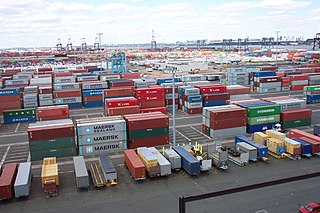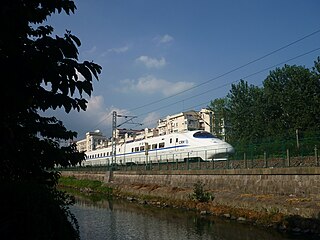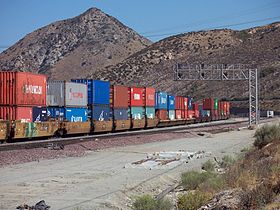
Containerization is a system of intermodal freight transport using intermodal containers. Containerization, also referred as container stuffing or container loading, is the process of unitization of cargoes in exports. Containerization is the predominant form of unitization of export cargoes, as opposed to other systems such as the barge system or palletization. The containers have standardized dimensions. They can be loaded and unloaded, stacked, transported efficiently over long distances, and transferred from one mode of transport to another—container ships, rail transport flatcars, and semi-trailer trucks—without being opened. The handling system is mechanized so that all handling is done with cranes and special forklift trucks. All containers are numbered and tracked using computerized systems.

An intermodal container, often called a shipping container, or a freight container, (or simply “container”) is a large standardized container designed and built for intermodal freight transport, meaning these containers can be used across different modes of transport – such as from ships to trains to trucks – without unloading and reloading their cargo. Intermodal containers are primarily used to store and transport materials and products efficiently and securely in the global containerized intermodal freight transport system, but smaller numbers are in regional use as well. It is like a boxcar that does not have wheels. Based on size alone, up to 95% of intermodal containers comply with ISO standards, and can officially be called ISO containers. These containers are known by many names: cargo container, sea container, ocean container, container van or sea van, sea can or C can, or MILVAN, or SEAVAN. The term CONEX (Box) is a technically incorrect carry-over usage of the name of an important predecessor of the ISO containers: the much smaller steel CONEX boxes used by the U.S. Army.

Intermodal freight transport involves the transportation of freight in an intermodal container or vehicle, using multiple modes of transportation, without any handling of the freight itself when changing modes. The method reduces cargo handling, and so improves security, reduces damage and loss, and allows freight to be transported faster. Reduced costs over road trucking is the key benefit for inter-continental use. This may be offset by reduced timings for road transport over shorter distances.

A loading gauge is a diagram or physical structure that defines the maximum height and width dimensions in railway vehicles and their loads. Their purpose is to ensure that rail vehicles can pass safely through tunnels and under bridges, and keep clear of platforms, trackside buildings and structures. Classification systems vary between different countries, and gauges may vary across a network, even if the track gauge is uniform.

Railway electrification is the use of electric power for the propulsion of rail transport. Electric railways use either electric locomotives, electric multiple units or both. Electricity is typically generated in large and relatively efficient generating stations, transmitted to the railway network and distributed to the trains. Some electric railways have their own dedicated generating stations and transmission lines, but most purchase power from an electric utility. The railway usually provides its own distribution lines, switches, and transformers.
Terra Transport (TT) was the name for the Newfoundland Transportation Division, a wholly owned subsidiary of Canadian National Railway (CN), created in 1979 as a means to organize the company's operations on Newfoundland.

A flatcar (US) is a piece of rolling stock that consists of an open, flat deck mounted on a pair of trucks (US) or bogies (UK), one at each end containing four or six wheels. Occasionally, flat cars designed to carry extra heavy or extra large loads are mounted on a pair of bogies under each end. The deck of the car can be wood or steel, and the sides of the deck can include pockets for stakes or tie-down points to secure loads. Flatcars designed for carrying machinery have sliding chain assemblies recessed in the deck.

The St. Clair Tunnel is the name for two separate rail tunnels which were built under the St. Clair River between Sarnia, Ontario and Port Huron, Michigan. The original, opened in 1891 and used until it was replaced by a new larger tunnel in 1995, was the first full-size subaqueous tunnel built in North America. It is a National Historic Landmark of the United States, and has been designated a civil engineering landmark by both US and Canadian engineering bodies.

Gauntlet track or interlaced track is an arrangement in which railway tracks run parallel on a single track bed and are interlaced in such a way that only one pair of rails can be used at any time. Since this requires only slightly more width than a single track, all rails can be carried on the same crossties/sleepers. Trains run on the discrete pair of rails appropriate to their direction, track gauge or loading gauge.

Rail freight transport is the use of railways and trains to transport cargo as opposed to human passengers.

The Beijing–Kowloon railway, also known as the Jingjiu railway is a dual track railway connecting Beijing West railway station in Beijing to Shenzhen railway station in Shenzhen, Guangdong Province.

A structure gauge, also called the minimum structure outline, is a diagram or physical structure that sets limits to the extent that bridges, tunnels and other infrastructure can encroach on rail vehicles. It specifies the height and width of station platforms, tunnels and bridges, and the width of the doors that allow access to a warehouse from a rail siding. Specifications may include the minimum distance from rail vehicles to railway platforms, buildings, lineside electrical equipment cabinets, signalling equipment, third rails or supports for overhead lines.

Rail transport in Europe has diverse technological standards, operating concepts, and infrastructures. Common features are the widespread use of standard-gauge rail, high operational safety and a high share of electrification. Electrified railway networks operate at many different voltages, both AC and DC, varying from 750 to 25,000 volts, and signaling systems vary from country to country, complicating cross-border traffic.
The Berne Gauge or Berne Convention Gauge is an informal but widely used term for the railway loading gauge considered the standard minimum loading gauge in most of Europe. The term arises from the international railway conference held and consequent convention signed in Bern, Switzerland in 1912. The official name of this gauge is the Gabarit passe-partout international, and it came into force in 1914.

A well car, also known as a double-stack car, is a type of railroad car specially designed to carry intermodal containers used in intermodal freight transport. The "well" is a depressed section that sits close to the rails between the wheel trucks of the car, allowing a container to be carried lower than on a traditional flatcar. This makes it possible to carry a stack of two containers per unit on railway lines wherever the structure gauge assures sufficient clearance. The top container is secured to the bottom container either by a bulkhead built into the car — possible when bottom and top containers are the same dimensions, or through the use of inter-box connectors (IBC). Four IBCs are needed per well car. In the terminal there are four steps: unlock and lift off the top containers of an inbound train, remove the bottom containers, insert outbound bottom containers, lock assembly after top containers emplaced. Generally this is done car-by-car unless multiple crane apparatus are employed.

The length of a train may be measured in number of wagons or in metres for general freight. Train lengths and loads on electrified railways, especially lower voltage 3000 V DC and 1500 V DC, are limited by traction and power considerations. Drawgear and couplings can also be a limiting factor, along with curves, gradients and crossing loop lengths.

Trailer on flatcar, also known as TOFC or piggyback, is the practice of carrying semi-trailers on railroad flatcars. TOFC allows for shippers to move truckloads long distances more cheaply than can be done by having each trailer towed by a truck, since one train can carry more than 100 trailers at once. The trailers will be moved by truck from their origin to an intermodal facility, where they will then be loaded onto a train, typically by a rubber tired gantry crane, for the bulk of their journey. Alternatively, trailers may be driven onto the flatcars via ramps by a terminal tractor. Near the destination, the trailers are unloaded at another facility and brought to their final destination by a tractor unit.

The Xiaoshan–Ningbo railway or Xiaoyong railway, is a double-track railroad in eastern China between Hangzhou and Ningbo in Zhejiang Province. Its name in Chinese, the Xiaoyong Line, is named after the railway's two terminal stations, Hangzhou South in Xiaoshan District of Hangzhou on the southern bank of Qiantang River, and Ningbo, whose Chinese character abbreviation is yong. The line is 147.3 km (92 mi) long and was originally built in three parts in 1912, 1914 and 1936; rebuilt in 1959, then electrified in 2009. Cities along route include Xiaoshan District of Hangzhou, Shaoxing, Shangyu, Yuyao and Ningbo, all in Zhejiang Province. The Hangzhou–Ningbo high-speed railway runs parallel to the line. The section between Ningbo and Zhuangqiao railway station is proposed to be quadruple-tracked.

Rail transport is an important mode of long-distance transportation in China. As of 2024, the country had more than 159,000 km (98,798 mi)[a] of railways, the second longest network in the world. By the end of 2023, China had more than 45,000 kilometres of high-speed rail (HSR), the longest HSR network in the world.

Intermodal railfreight in Great Britain is a way of transporting containers between ports, inland ports and terminals in England, Scotland and Wales, by using rail to do so. Initially started by British Rail in the 1960s, the use of containers that could be swapped between different modes of transport goes back to the days of the London, Midland & Scottish Railway.


























